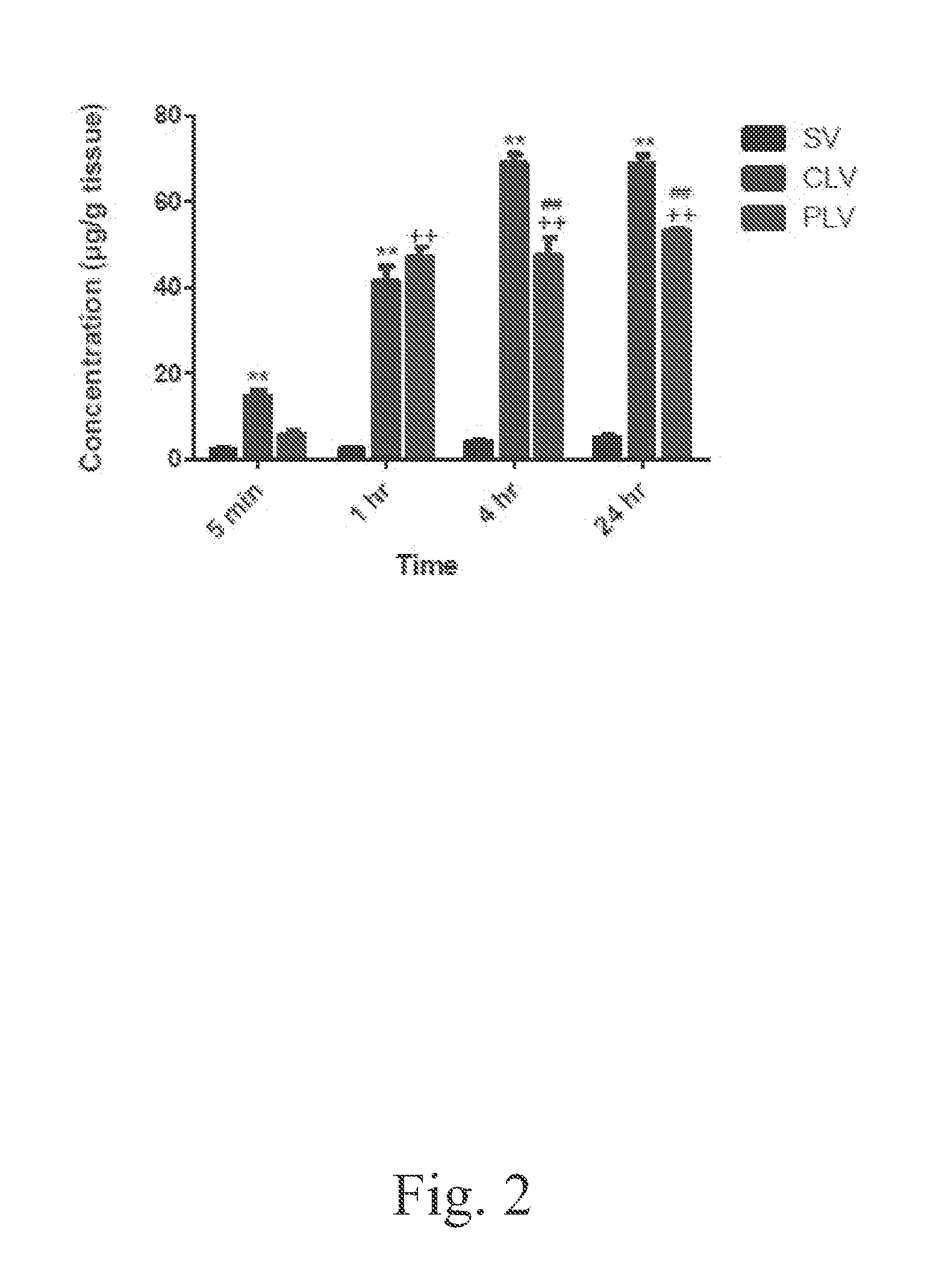Novel formulation of pegylated-liposome encapsulated glycopeptide antibiotics
a glycopeptide, pegylated-liposome technology, applied in the direction of antibacterial agents, peptide/protein ingredients, drug compositions, etc., can solve the problems of vancomycin's effectiveness reduction, poor penetration of lung tissue, and common problems
- Summary
- Abstract
- Description
- Claims
- Application Information
AI Technical Summary
Benefits of technology
Problems solved by technology
Method used
Image
Examples
example 1
Preparation of Liposomal Vancomycin Formulations
[0029]Liposomes were prepared using one of three methods: 1) the thin film hydration method (23); 2) the ammonium sulfate gradient method (24); and a modified dehydration-rehydration method (25).
[0030]To prepare liposomes by the thin film method, 287 mg of 1,2-distearoyl-sn-glycero-3-phosphocholine (DSPC) (Genzyme Pharmaceuticals, Cambridge, Mass.) and 52 mg of cholesterol (Sigma Chemicals, St. Louis, Mo.) were dissolved in 7 ml of HPLC grade chloroform (EMD Chemicals, Gibbstown, N.J.), and evaporated to a film in a rotary evaporator (Buchi Rotavapor R-200, Switzerland). The film was stored overnight at room temperature in a vacuum desiccator, thus allowing the formation of a thin layer of lipid film. The thin lipid film was hydrated by adding vancomycin solution (100 mg of vancomycin hydrochloride (Sigma Chemicals, St. Louis, Mo.) dissolved in 10 ml of phosphate buffered saline (PBS) pH 7.4 (Sigma Chemicals, St. Louis, Mo.)) to the fl...
example 2
[0042]Groups of at least 52 mice (Male CF-1 mice from Charles River Lab, Wilmington, Mass.) each received a tail vein injection of a single dose of 5 mg / kg of vancomycin prepared either as a standard vancomycin solution, a conventional formulation of liposome-encapsulated vancomycin, or a formulation of PEGylated liposome-encapsulated vancomycin, respectively. Following the drug administrations, three mice from each different vancomycin formulation group (vancomycin solution, conventional liposome, and PEGylated liposome) were sacrificed by isoflurane (Piramal Health Care, Ltd., AP, India) inhalation at predetermined time points (5, 15, 30 and 45 min, 1, 2, 3, 4, 5, 6, 8, 12, 24 and 48 h). Blood was collected from the sacrificed mice at every time point. Liver, kidney, spleen, lung, and muscle tissues were collected at 1, 4, and 24 h.
[0043]Blood samples were placed in heparinized micro-centrifuge tubes, and plasma was separated by centrifugation. A simple protein pre...
example 3
Bio-Distribution
[0047]The bio-distribution of vancomycin into the liver, kidneys, lungs, spleen, and muscle following administration of a single intravenous dose of 5-mg / kg of standard, conventional, and PEGylated liposomal vancomycin formulations was determined. The administrations of the foregoing formulations to the respective groups of mice, and the post-administration sacrifice schedule, were performed as described by Example 2. Tissues were prepared and analyzed according to the following protocols.
[0048]As explained above, several major organs (liver, kidney, lung, spleen, and muscle) were analyzed to determine the distribution of vancomycin in these tissues 1, 4, and 24 h after intravenous administration of vancomycin prepared either as a standard vancomycin solution, a conventional formulation of liposome-encapsulated vancomycin, or a formulation of PEGylated liposome-encapsulated vancomycin, respectively. Tissue samples were weighed and homogenized in PBS (0.5 mg / ml for li...
PUM
| Property | Measurement | Unit |
|---|---|---|
| average molecular weight | aaaaa | aaaaa |
| average molecular weight | aaaaa | aaaaa |
| average molecular weight | aaaaa | aaaaa |
Abstract
Description
Claims
Application Information
 Login to View More
Login to View More - R&D
- Intellectual Property
- Life Sciences
- Materials
- Tech Scout
- Unparalleled Data Quality
- Higher Quality Content
- 60% Fewer Hallucinations
Browse by: Latest US Patents, China's latest patents, Technical Efficacy Thesaurus, Application Domain, Technology Topic, Popular Technical Reports.
© 2025 PatSnap. All rights reserved.Legal|Privacy policy|Modern Slavery Act Transparency Statement|Sitemap|About US| Contact US: help@patsnap.com



